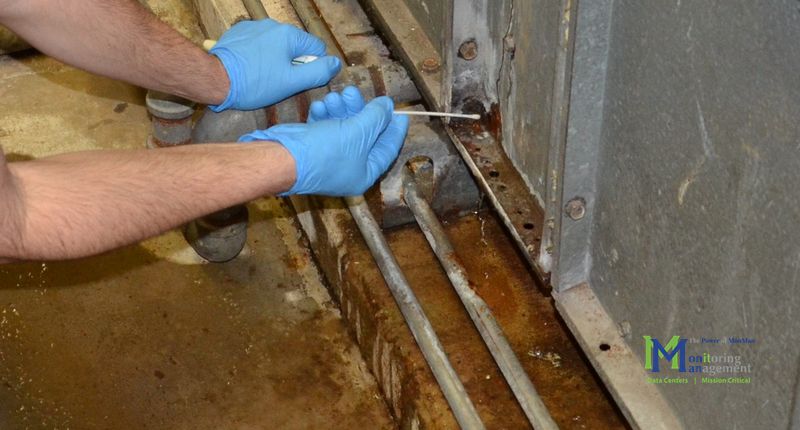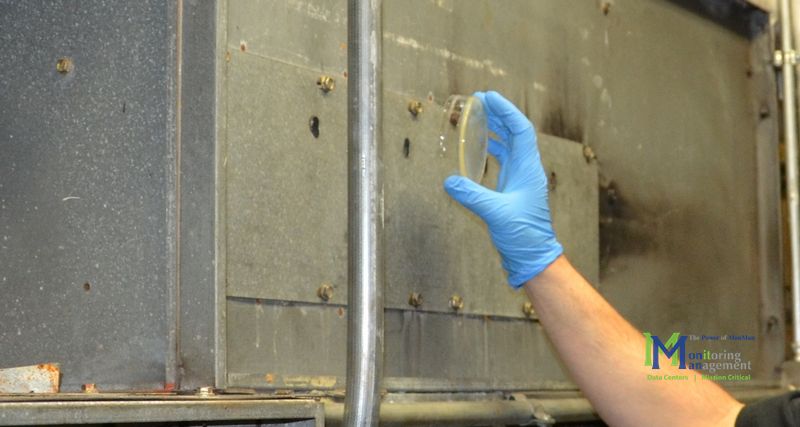Ebola, Flu, and Hidden Germs in the Hospital's Attic

In the image above, a sample is taken from a rusted hole in the air handling unit. High velocity air and water were leaking out of the air handling unit at this location. This sample point is after the filters, meaning any contaminants at this point in the unit could easily make their way into the operating room.
I should have known they’d be on high alert, but I wasn’t expecting to be treated like a walking biohazard when I went for my yearly physical.
Sure, we all figured the recent Ebola outbreak would change the way the healthcare industry handles infectious diseases, but I had no idea it would hit so close to home.
Bright red posters greeted me in the lobby: “STOP: Do you have a fever, cough or are vomiting? See a nurse immediately.”
Even though I’ve been a patient here for years, I had new forms to fill out this time around, with questions like: “Was I feeling sick with a fever?” “Had I traveled to West Africa in the past 21 days?” “Have I been exposed to anyone who has, or anyone who had been in contact with someone who has traveled to West Africa in the past 21 days?”
What? West Africa? I hadn’t even been out of town!
It was coming up on Flu season, and though my checkup had to be scheduled a few weeks in advance because of a patient backlog, I honestly considered walking out of the doctor’s office and waiting until the whole thing blew over.
Everybody Knows About it, But Nobody’s Talking
Despite the warning signs plastered on the wall, no one was talking about it. No one said “Ebola”. It wasn’t mentioned on the forms. The receptionist didn’t speak its name. It was like we were in some show where we already knew the ending, but we kept playing along like good little actors. No one wanted to be the guy to shout “Fire!” in a theater. (Or to shout “Ebola!” on a plane.)
As I was mulling it over in my head, the nurse jolted me back to reality when she called my name.
The Signs are all Here
She took the usual notes: height, weight, blood pressure. She asked the usual questions: has your information changed? Are you still a non-smoker?
I wasn’t expecting much more from a yearly checkup.
“Do you have a fever, chills or are you vomiting?” she asked.
“Um, no, this is my regular checkup.” I replied.
“Sorry, just a new set of questions we’re required to ask,” she assured me.
“Have you traveled to West Africa in the past 21 days?”
“No, I haven’t been out of the country in years.”
I thought to myself: “21 days… 21 days…” Finally I had one of those ‘Ah-Ha!’ moments. 21 Days. That’s the incubation time for Ebola that’s been all over the news.
Confident I wasn’t secretly treating Ebola patients in my spare time, the nurse finished and I was left alone to wait on the doctor.
As I waited, I gazed around the clean, bright room. Blood pressure cuff, swabs, gauze. I looked up. Bright lights and ceiling, an air conditioning vent. Hmmm, I thought to myself, "I wonder what kind of germs are coming out of that vent?"
Meet the Elephant
Despite the headline, this article isn’t about Ebola. It’s not even about the flu, although the 2014-2015 flu season is turning out to be worse than predicted.
I’m not even talking about the CDC, the doctors, nurses or the patients. This is about the silent killers that don’t get the headlines. The things most of us don’t even know exist. This is about the nasties hiding in the darkest corners of hospitals.
I found it interesting that at the time, there was only 1 confirmed Ebola death in the United States, a man who was infected in West Africa and arrived in the U.S. already in terrible condition, yet we were collectively 'freaking out' about Ebola.
A few voices of reason in the crowd reminded us that far more people die from the flu each year than Ebola.
It made sense to me. But if that were true, what about other diseases? True, dying from Ebola or the flu is a scary thought, but compared to other diseases, deaths from those two are actually quite rare. Where does the real danger lie?
Fixing Old Air Handlers For A Living

In the image above, discharge air (positive pressure) leaking out of several holes in ductwork is collected with a Petri dish. This procedure was duplicated on the return air side (negative pressure) from inside the return ductwork.
Part of my job keeps me up to date in the HVAC industry, especially in the healthcare market. I’ve crawled my way through some dark, dirty places in hospitals; places the patients and the doctors don’t even know exist.
I replace old air handlers. You know, the big metal boxes that heat, cool and filter the air in hospitals? You've probably never thought about them and I can't blame you; they're usually up on the roof or hidden down in a basement somewhere.
In a sense, they're the lifeblood of the hospital. They usually work well, chugging along in corner closets and basements, away from patients and doctors. When they stop working, things can go wrong, and fast. But that's a rare occurrence since facilities and maintenance personnel do a good job of keeping the motors well-lubed and the filters changed.
I don't work for the CDC and I’ve never “scrubbed in” to a sterile field to perform a surgery, but I know a thing or two about air conditioning systems in hospitals. And from what I had seen in the past, I needed to know more.
Deciding that I wanted to know for myself just how bad things might be, I convinced everyone at my company, MonMan, to conduct a study. I said “Let’s find out just how dirty the air in a hospital is!”
What we found was amazing.
The Cleanest Hospital HVAC System You'll Ever See... Isn't So Clean
While we knew getting some really colorful mold growing in a Petri dish would get a lot of attention, it would be far too easy.
I've seen hospital air conditioners with rusted out bases, holes big enough to fit your fist through, visible mold growing inside and out, and more.
The oddest thing I've seen so far is an air handler that had its bottom rusted out, so it was replaced with plywood.
If you know anything about air conditioners, you know they can get hot, cold, wet and dark. Perfect breeding grounds for all sorts of nasty bugs.
But taking samples at one of the hospitals we've worked with in the past by replacing their old air handlers would be too easy. We knew they have issues they are still working out.
What about a first-class hospital? One with high tech surgery suites with hundreds of patient beds? What kind of germs were hiding there?
Doing the Dirty (Work)
So we set out to get permission from one of the largest hospitals in the United States (whose name shall remain anonymous as part of our agreement). After speaking with their facilities, nursing and legal department, we got the "go ahead" to take samples from one of their air handlers.
Now, this hospital is huge. It's a sprawling complex in a major metropolitan area. It has orthopedic specialists, heart surgeons, brain surgeons, a maternity ward and of course a huge outpatient surgery center. Of all the hospitals in the country, and perhaps the world, surely this one would be contaminant-free!
Which air conditioner should we choose? Which one do you think would be the cleanest?
We decided to take samples from an air handler serving an operating room that handles cases from back surgery, appendicitis and even heart surgery.
If any air conditioner should be clean, surely it would be this one!
The specifics of our study can be found here. But in short, we took samples at over ten points in the air handling system. We took bacterial and mold samples from the air coming back from the operating room, samples inside the unit itself, and of course, samples of the air heading back into the OR.
(Note: We scheduled the sampling during a downtime, while no patients were in the operating room, so no one was at any risk).
What we found was astonishing.
The Results are in, and You Should Be Concerned
Out of 10 sample points, every single one showed microbial contamination of some type. Every sample point was contaminated with either bacteria, mold, or both.
Now, we live in a world filled with germs. They are all around us, and are unavoidable. But the types of contamination, and where we found them worries us.
The list of bacteria we found growing inside this air handler and the ductwork connected to it is as follows. The mold we found growing was even more diverse (see photos below):
Top 5 Bacteria Found Inside the Hospital HVAC System Serving an Operating Room:
1) Alcaligenes faecalis: As its name implies, it was first discovered in feces. It's scary to know it's living inside an air conditioning unit. It's actually a fairly harmless bacteria, but it can cause urinary tract infections. And besides, found in feces? Gross.
2) Leifsonia aquaticum: If you thought bacteria found in poop was weird, how about this one? Leifsonia bacteria are typically associated with infections of sugarcane. So how exactly did it get into the ventilation system of an air handling unit?
When it's not ruining crops, it can sometimes infect humans and cause endocarditis, meningitis, peritonitis, and urinary tract infections. In severe cases, it can lead to sepsis, organ failure and death.
3) Pseudomonas oryzihabitans: Ok. Pseudomonas. That rings a bell. Now it seems like we're getting into familiar territory. While this particular little bug isn't as harmful as some of its Pseudomona brethren, it is an opportunistic bacteria that can infect immuno-compromised patients or people using catheters or IVs.
This bacteria thrives in wet and damp environments, and that makes sense, because we took this particular sample in a puddle of water inside of the air handling unit! (Note: Air conditioners should NOT have standing water inside)
This bacteria is still relatively easy to treat with many types of antibiotics, but it has developed resistance to some very common penicillin-like antibiotics including ampicillin, amoxicillin-clavulanic acid (Augmentin), and even cefazolin (a powerful cephalosporin type drug).
The part we need to pay attention to, however, is that this is an opportunistic bacteria that can quickly take hold in immuno-comprimised patients (AIDS, Leukemia, etc.), and is readily spread while patients are hospitalized and especially during surgery.
Did I mention we found it in the air conditioner that blows air into an operating room?
4) Methylobacterium mesophilicum: This is one of the two most commonly found bacteria in clinical samples. It is especially mean to immuno-compromised patients, like those found in a hospital operating room.
When we talk about bacterial resistance, we usually mean resistance to antibiotics. There are still some very effective chemicals that can disinfect non-organic surfaces very well with little concern for bacterial resistance (like isopropyl alcohol, chlorine-based disinfectants, etc.)
The scary part about this particular bacteria is that is has shown resistance to one of the most potent disinfectants we have in our arsenal. I can't do it justice, so I am going to cite directly from wikipedia and the associated references:
Methylobacteria have been reported to exhibit resistance to chlorination and have been isolated from tap water in various clinical settings including: an investigation of a pseudo-outbreak, water from dental units, and blood purification units. Tap water is a suspected mode of transmission. The presence of these organisms in tap water prompted suggestions that it may be helpful to monitor these organisms in water distribution systems in hospital units for immuno-compromised patients.
How did this bacteria make its way into the ventilation system that serves an operating room? Perhaps more importantly, how could it be eradicated, given its resistance to chlorination?
5) Pseudomonas putida: Ok, this one is just weird. It's not especially infectious or harmful to humans, but it has the most interesting story of them all.
This bacteria was the first genetically-modified organism to be patented. That's right, Ananda Mohan Chakrabarty, a genetic engineering researcher for GE, invented this bacteria (or a close cousin, based on this bacteria) and even won a court case against the commmissioner of the U.S. Patent & Trademark Office which gave him a patent on it.
Now, in the past, this bacteria has been called the "oil-eating" bacteria, because it can biodegrade many types of substances including oil, solvents and even caffeine. This type of research was conducted in the 1960s and 70s.
More recently, however, this, and other similar bacteria, have been used in genetic engineering research for various purposes, including cancer cell regression, genetic therapeutics and arresting cell cycle progression.
Genetic engineering based on this bacteria is ongoing not only at several labs around the world, but at a few select hospitals in major metro areas.
This little bug could possibly cure cancer or even slow the aging process. How did it end up here, in the operating room of a hospital in one of the largest cities in the United States?
So, How Can We Improve the Conditions in Our Hospitals?
Hospitals have been called one of the safest places to be, because if anything happened to you, you'd be right there with the nurses and doctors who can take care of you.
Unfortunately, the reason we have to go to hospitals in the first place is because we are sick. So while hospitals are the best place to get all sorts of treatments, they're also a breeding ground for all the microbes that hitch a ride on the patients.
The company I work for, MonMan, is deeply involved in the healthcare industry, and we've improved the cleanliness of many aging HVAC systems. One way to do this is to keep the ductwork clean, but sometimes, the air handler itself is the problem, and needs to be changed out. You can even add UV-C disinfection systems to help kill microbes in a hospital's ventilation system.
But in a sense, it comes back to a basic truth: we each have to do the best we can, and the rest is out of our control. Despite all of our advanced medicine, technologies and techniques, we don't always know what is lurking around the next corner.
In the meantime, wash your hands, cover when you sneeze, and the next time you're on the operating table, hope your hospital has a clean ventilation system.
*****
If you'd like to know more about our study, the techniques we used and for much more detailed information, please see the technical post that accompanies this article.
*****
Copyright Notice: All text, intellectual property and images in this article are the sole property of Monitoring Management (MonMan). For questions regarding licensing or use of this material, please contact us. Unauthorized use or redistribution will be considered a violation of copyright law.
Basically, if you'd like to use this information, please ask us, and be sure to cite us as the source and link back to this article. Thanks!








